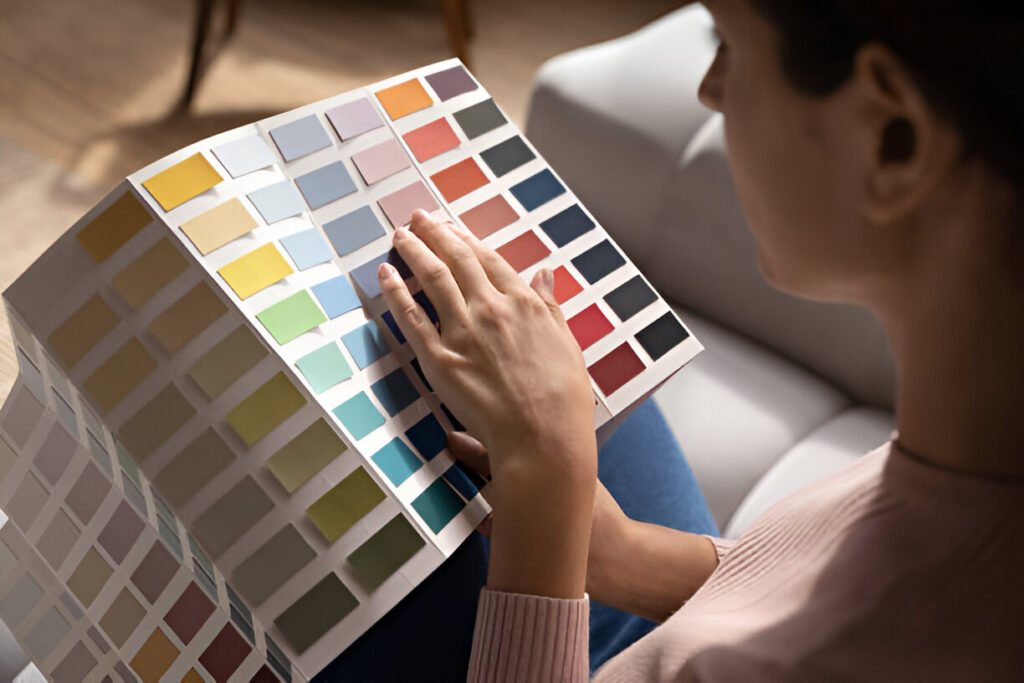Finding the perfect color palette for your home can feel a bit like picking the right outfit for a big event. Just as you wouldn’t wear something that doesn’t fit your style or mood, the colors in your home should reflect your personality and the ambiance you want to create. So, how do you choose a color palette that suits your home and makes it a space you love? Let’s dive in!

Understanding Color Psychology
Colors have an incredible impact on our mood and feelings. For example, warm colors like red and orange can create a lively, energetic vibe, while cool colors like blue and green tend to promote calmness and serenity. Think of it this way: when you walk into a bright, sunny room painted in yellow, it might uplift your spirits, much like stepping outside on a beautiful day. Understanding the psychology of colors can help you decide what mood you want to cultivate in your home.
Determining Your Style
Before you start selecting colors, it’s essential to determine your personal style. Are you more traditional, modern, or eclectic? Your style will guide your color choices. For instance, if you lean towards a modern aesthetic, you might prefer sleek, monochromatic palettes. Conversely, a more eclectic style may embrace bold colors and unexpected combinations. Reflect on what makes you feel comfortable and happy.
Inspiration from Nature
Nature offers a fantastic source of inspiration for your color palette. Look at the landscapes around you—think of the hues in a sunset or the greens of a forest. You can create a calming home environment by pulling colors directly from nature. For instance, a coastal theme might incorporate soft blues, sandy beiges, and white accents reminiscent of the beach.
Using a Color Wheel
A color wheel is an essential tool when selecting your color palette. It visually represents colors and their relationships, helping you choose complementary colors or shades that work well together. If you’re unsure where to start, you can select one color as your base and find its complementary color on the wheel. This is similar to mixing paint; a little of one color can dramatically change the overall hue.
Choosing a Dominant Color
Every good color palette has a dominant color that sets the tone for the entire space. This color typically covers the most significant area, such as walls or large furniture pieces. When selecting your dominant color, consider how it will interact with natural light and the other colors in the room. It should create a welcoming and harmonious atmosphere.
Accent Colors: Making a Statement
Accent colors are like the jewelry in your home—they add personality and flair! These colors can be bolder and are often used in smaller doses, such as on throw pillows, artwork, or decorative pieces. A bright orange accent in a neutral room can add just the right amount of pop, making the space feel lively and interesting.
Creating Cohesion with Neutrals
Neutrals are the backbone of a well-thought-out color palette. They provide balance and allow your accent colors to shine. Colors like white, gray, and beige can help unify your space, making it feel cohesive and organized. Think of neutrals as the background music that supports a great performance; they set the stage without overpowering it.
Considering Lighting
Lighting plays a crucial role in how colors appear in your home. Natural light can make colors look different throughout the day, while artificial light can also change their appearance. Before committing to a color, observe how it looks in various lighting conditions. Try painting a small section of your wall and watching it at different times of the day to see how it changes.
Testing Colors in Your Space
Once you have a few color ideas, it’s time to test them in your space. Purchase sample paints and apply them to the walls. Don’t just look at them during the day—check how they appear in the evening as well. This testing phase is crucial; it ensures that the colors you choose align with your vision.
Understanding the Flow Between Rooms
When selecting a color palette, it’s essential to consider how colors flow between rooms. You don’t want one room to feel jarring compared to the next. Creating a harmonious transition can be achieved by using similar hues or varying shades of the same color family. This approach ensures your home feels cohesive and interconnected.
Staying Trendy vs. Timeless
While it can be fun to incorporate trendy colors, consider how they fit into a timeless design. Trends can quickly become outdated, so choose a color palette that will remain appealing for years to come. A classic combination, like navy and white, never goes out of style and can be easily updated with changing accessories.
Incorporating Patterns and Textures
Once you’ve settled on your main colors, think about how patterns and textures can enhance your palette. Textured fabrics like woven rugs or patterned throw pillows can add depth to your space. It’s like adding layers to your outfit; a mix of textures and patterns creates visual interest and keeps things exciting.
Budgeting for Your Color Palette
Creating your perfect color palette doesn’t have to break the bank. Consider what you can afford to spend on paint, furniture, and accessories. Prioritize larger areas like walls for investment colors, and use smaller accents for more affordable options. Always keep an eye out for deals or DIY solutions to stay within budget.
Getting Professional Help
If you feel overwhelmed, don’t hesitate to seek professional help. Interior designers can provide expert advice tailored to your style and needs. They can also help you visualize how different colors will work together, making the process smoother and more enjoyable.
Maintaining Your Color Palette
Once you’ve chosen your color palette, it’s essential to maintain it. Regular cleaning and care for your painted walls, furniture, and decor can help keep your colors looking fresh and vibrant. Regular touch-ups can also help prevent the need for complete redecoration.
